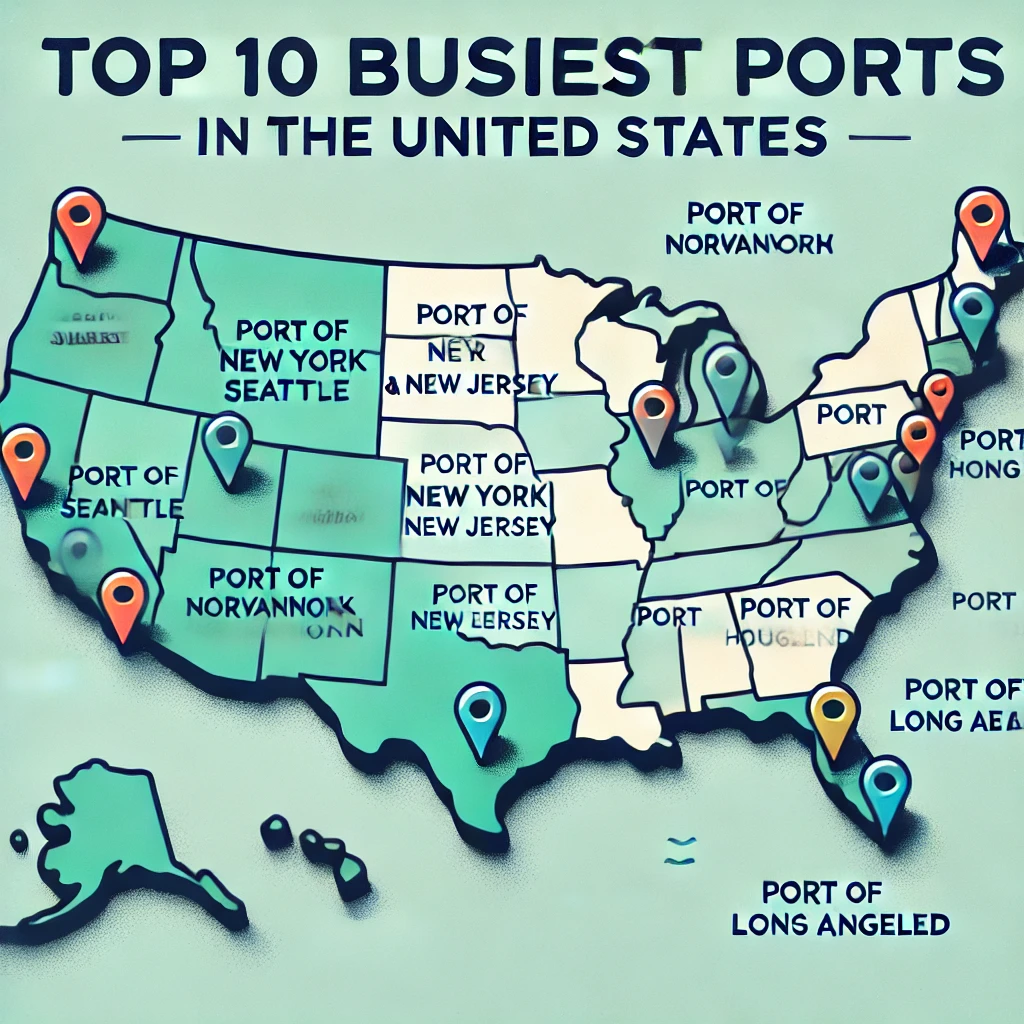The US has some of the busiest and most critical ports in the world for international trade. These ports are not only the main gateways for goods moving in and out of the US but also important hubs supporting the global supply chain and contributing significantly to the US economy. This blog will examine the top 10 US ports in-depth, focusing on their central role and importance in shipping and logistics.

List of the 10 busiest ports in the US
Port of Los Angeles
- Location: Located in Los Angeles, California, USA.
- Overview: The Port of Los Angeles is the largest port in the United States and one of the busiest container ports in the world. It shares the same port area with the Port of Long Beach, which is next to it, collectively known as the “Port of Los Angeles.” The port mainly handles imported goods, especially consumer goods, electronics, clothing, automobiles, etc. from Asia.
- Features: The Port of Los Angeles has substantial logistics facilities and deep-water berths capable of accommodating the world’s largest container ships. Its efficient automated facilities and large-scale container handling capabilities make it a key hub in the global supply chain. In addition, the Port of Los Angeles is a vital trade channel between the West Coast of the United States and Asia, Europe, Australia and other places.
Port of Long Beach
- Location: Located in Long Beach, California, USA, adjacent to the Port of Los Angeles.
- Overview: The Port of Long Beach shares a port area with the Port of Los Angeles and is one of the busiest container ports in the world. It is particularly good at handling containerized cargo imported from Asia, covering a variety of commodities such as automobiles, electronics, clothing, toys, and more. It cooperates closely with the Port of Los Angeles to form one of the most important port clusters in the world.
- Features: The Port of Long Beach is known for its efficient cargo handling capabilities and advanced logistics infrastructure. The port has deep-water berths and large-scale container handling capabilities. It has also introduced many environmental protection measures, such as reducing air pollution and promoting green technologies. Its location near downtown Los Angeles makes it an essential gateway to the interior of the United States.
Port of New York and New Jersey
Location: Located in the northeastern United States, covering New York City and New Jersey port areas.
Overview: The Port of New York and New Jersey is the largest port on the East Coast of the United States and one of the world’s important container transportation centres. It provides many imported goods to New York City and the surrounding areas, especially consumer goods, industrial products and raw materials. The port’s diverse cargo handling capabilities make it a significant channel for imported goods in the United States.
Features: Advanced infrastructure and extensive multimodal transport network. The port’s deep-water terminal can accommodate large ships and is a key hub for routes from Asia to the East Coast of the United States.
Port of New York and New Jersey
- Location: Located in the northeastern United States, covering New York City and New Jersey port areas.
- Overview: The Port of New York and New Jersey is the largest port on the East Coast of the United States and one of the world’s important container transportation centres. It provides many imported goods to New York City and the surrounding areas, especially consumer goods, industrial products and raw materials. The port’s diverse cargo handling capabilities make it a significant channel for imported goods in the United States.
- Features: Advanced infrastructure and extensive multimodal transport network. The port’s deep-water terminal can accommodate large ships and is a key hub for routes from Asia to the East Coast of the United States.
Port of Savannah
- Location: Located in Savannah, Georgia, USA.
- Overview: The Port of Savannah is one of the largest and fastest-growing container ports in the southeastern United States. Its deepwater port accommodates the needs of large ships and is an important gateway connecting the United States with global markets.
- Features: The port’s advantages in container transportation, especially its high-speed cargo handling capabilities, can be called the “king of efficiency”. The “ultra-modern” equipment of the Port of Savannah makes it a major global trade centre.
Port of Norfolk
- Location: Norfolk, Virginia, USA, near the Chesapeake Bay.
- Overview: The Port of Norfolk is one of the largest natural deepwater ports in the United States. It serves the East Coast and global markets. It is also the intersection of important routes from the East Coast to Europe and Asia.
- Features: Deepwater berths accommodate large ships and have extensive rail and road transportation connections, especially suitable for transporting military supplies and other heavy cargo.
Port of Seattle
- Location: Located in Seattle, Washington, USA.
- Overview: The Port of Seattle is one of the largest ports in the Pacific Northwest of the United States and is closely connected to Asian routes. As a significant trading port in the United States, the Port of Seattle is essential in the global supply chain.
- Features: The port handles a variety of cargo, including containers, bulk cargo, and bulk commodities. It has close ties with ports in Canada and other Asia-Pacific regions and is an important hub for trade between the United States and other Asian countries.
Port of Houston
- Location: Located in Houston, Texas, USA.
- Overview: The Port of Houston is the busiest port in the south-central United States, especially in the transportation of oil and chemicals. It is one of the world’s important oil and gas export ports and an important part of the US energy supply chain.
- Features: In addition to container transportation, the Port of Houston is particularly good at handling bulk cargo, liquid cargo and petroleum products. There are a large number of oil refining facilities near the port, making its role in the energy industry crucial.
Port of Oakland
- Location: Oakland, California, USA, near San Francisco Bay.
- Overview: The Port of Oakland is one of the major container ports on the West Coast of the United States and one of the busiest ports in California. The port has a strong logistics and supply chain network, especially in transporting goods between the western United States and Asia.
- Features: The Port of Oakland excels in handling containers, bulk cargo, and special cargo. Its efficient cargo handling system and strong land transportation connections make it essential in the trans-Pacific route.
Port of Charleston
- Location: Located in Charleston, South Carolina, USA.
- Overview: The Port of Charleston is one of the important ports in the southeastern United States, especially in terms of competitive container transportation. Due to its efficient operations and deep-water terminals, the port has become a key node in global trade.
- Features: The Port of Charleston has deep-water berths and fast loading and unloading capabilities, making it capable of handling large ships. Its transportation network covers the United States East Coast and is closely tied to many vital ports worldwide.
Port of Miami
- Location: Located in Miami, Florida, USA.
- Overview: Port Miami is an essential international port in the southeastern United States, especially in its role in Latin American trade. It is an important shipping hub connecting the Americas to the rest of the world.
- Features: The Port of Miami has deep-water terminals capable of handling large container ships. It also significantly impacts tourism and cruise shipping, attracting a large number of tourists and cargo flows.
How many ports are there in the United States?
The United States has more than 360 major commercial ports along the coastline, rivers, and inland waterways, supporting trade and economy. According to the US Coast Guard and Maritime Administration (MARAD), these ports include:
- Deepwater ports, such as the Port of Los Angeles, the Port of Long Beach, the Port of New York-New Jersey, etc., mainly handle international container transportation and extensive cargo.
- Inland river ports, such as those along the Mississippi River, transport bulk commodities such as grain, coal, and oil.
- Coastal ports are distributed along the Atlantic, Pacific, and Gulf of Mexico coasts, connecting domestic and international shipping networks.
- Great Lakes ports: ports along Lake Erie and Lake Michigan, supporting trade between the United States and Canada.

Which is the largest port in the US?
The largest port in the United States is the Port of Los Angeles. It is the busiest container port in the United States and the entire Western Hemisphere, located in San Pedro Bay in Los Angeles, California. Unrivalled in North America, its efficiency and scale guarantee global trade.
FAQ
The United States has over 360 commercial ports, including deep-water and inland ports. These ports are strategically distributed along the Atlantic, Pacific, and Gulf Coasts, as well as in the Great Lakes region and major inland waterways.
The Port of Los Angeles is the largest in North America, handling over 9 million TEUs annually. It is located in San Pedro Bay, California, a key gateway for U.S.-Asia trade. The port has advanced facilities, significant economic contributions, and leading sustainability initiatives.
Los Angeles, California, has the largest U.S. port by cargo volume. The Port of Los Angeles, situated in the San Pedro Bay area, is the busiest container port in the country and a major gateway for trade between the U.S. and Asia. It handles over 9 million TEUs (Twenty-Foot Equivalent Units) annually, making Los Angeles the city with the largest port in the United States.
The Port of New York and New Jersey is the most famous U.S. port. It is located near New York City and symbolizes America’s economic and cultural connection to the world. It is known for its historical significance as a gateway for immigrants and its modern role as the busiest port on the East Coast.



